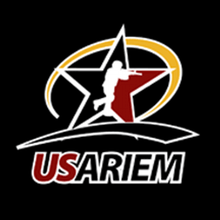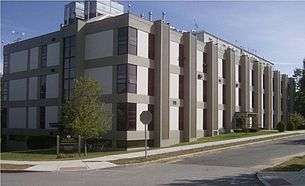United States Army Research Institute of Environmental Medicine
| U.S. Army Research Institute of Environmental Medicine | |
|---|---|
 The USARIEM logo | |
| Active | 1961–present |
| Country |
|
| Branch |
|
| Type | Medical R&D Command |
| Role | Military medical research and development |
| Garrison/HQ | U.S. Army Soldier Systems Center, Natick, Massachusetts, USA |

The U.S. Army Research Institute of Environmental Medicine (USARIEM) is the U.S Army’s main institution and facility for military environmental medicine and exercise physiology research. It is located at Natick, Massachusetts, within the U.S. Army Soldier Systems Center (SSC) installation, but is a subordinate lab of the U.S. Army Medical Research and Materiel Command (USAMRMC), headquartered at Fort Detrick, Maryland, USA.
Mission
USARIEM’s Mission Statement mandates that the Institute:
Provide solutions to enhance Warfighter health and performance through medical research.
The Institute has four divisions, each relating to military human performance as it relates to the environment — Biophysical and Biomedical Modeling, Military Nutrition, Military Performance, and Thermal and Mountain Medicine. Research in the divisions focuses on three elements: the servicemember (acclimation; body size; gender; race; age; health; hydration; nutrition; fitness; and sleep status), the environment (temperature; wind; humidity; and altitude), and the mission (work — intensity, duration, and type; clothing and equipment; and medications).
Research on the effect of environmental pollutants on military personnel is not part of USARIEM's mission, but is within the purview of the U.S. Army Center for Environmental Health Research at Fort Detrick, Maryland.
History
USARIEM traces its institutional lineage back to 1927 and the Harvard Fatigue Laboratory. That facility fostered two institutions that ultimately merged. The first was the Climatic Research Laboratory in Lawrence, MA (1943–54), which relocated to Natick in 1954 under the new name of the Environmental Protection Research Division (EPRD) of the U.S. Army’s Quartermaster Research and Engineering Command. The second was the Armored Medical Research Laboratory (AMRL) at Fort Knox, KY (1942–61) elements of which joined with the EPRD in 1961 to constitute the present USARIEM facility and organization.
Products and capabilities
USARIEM’s basic and applied research capabilities are focused upon biomedical evaluations, health hazard assessments, countermeasures development and a rapid response to a diverse range of environmental threats and problems. Products include individual soldier equipment and rations; guidelines pertaining to training policy and preventive medicine; and performance monitoring strategies and predictive algorithms.
Research Divisions
Research divisions within USARIEM consist of Biophysics and Biomedical Modeling (which develops biomedical models to simulate effects of heat, cold, high altitude, hydration, nutritional status and clothing systems and equipment), Military Performance (which researches performance enhancements [physical, cognitive, behavioral, psychomotor] in military occupational tasks), Military Nutrition (which researches nutritional issues, including new rations, affecting servicemembers), and Thermal and Mountain Medicine (which researches physical and cognitive work capabilities and medical problems associated with military operations at high terrestrial altitude or temperature extremes).
Facilities
USARIEM maintains several unique or highly specialized facilities:
- Hypobaric Chamber Facility or HCF (altitude chambers)
- Two Class D chambers (man-rated) rarefied air atmosphere, non-oxygen enriched
- Large Study Chamber: internal volume of 2000 cu. ft. (floor area 200 sq. ft.)
- Small Study Chamber: internal volume of 1100 cu. ft. (floor area 108 sq. ft.)
- Environmentally controlled (altitude, temperature, humidity) & connected by an airlock
- Simulates altitudes of 800-225 Torr (sea level to 9000 m)
- Temperatures from -32 °C to 43 °C
- Relative humidity (Rh) between 20-80% (dew point dependent)
- 23,656 simulated altitude exposures of human volunteers over 33 years of studies[1]
- Two Class D chambers (man-rated) rarefied air atmosphere, non-oxygen enriched
- 13 Environmental Chambers
- Temperatures from -10 °C to 50 °C
- 5 Biophysical Evaluation Chambers
- Temperatures from -10 °C to 50 °C
- Biomechanics Laboratory
- Water Immersion Laboratory[2]
- Temperatures from 5 °C to 45 °C
- Human Exercise Physiology Laboratory
- Human/Animal Physiology Laboratory
- Psychology Laboratory
- Electron Microscopy Laboratory
- Animal Housing and Care Facility
- Doriot Climatic Chamber Complex
- Temperatures from -57 °C to 74 °C
- Laser and Flow Cytometry
Off site:
- United States Army Pike’s Peak Research Laboratory
- Located in Colorado at 4,300 m
List of USARIEM commanders
| Number | Tenure | Commander |
|---|---|---|
| 1 | 1961–1962 | CPT Robert J.T. Joy, MD |
| 2 | 1962–1965 | LTC William H. Hall, MD |
| 3 | 1965–1971 | COL James E. Hansen, MD |
| 4 | 1971–1976 | COL LeeRoy G. Jones, MD |
| 5 | 1976–1980 | COL Harry G. Dangerfield, MD |
| 6 | 1980–1982 | COL Eliot J. Pearlman, MD |
| 7 | 1982–1984 | COL Ernest M. Irons, Jr., MD |
| 8 | 1984–1986 | COL Brendon E. Joyce, MD |
| 9 | 1986–1989 | COL David D. Schnakenberg, PhD |
| 10 | 1989–1990 | COL Joseph C. Denniston, DVM |
| 11 | 1990–1994 | COL Gerald P. Krueger, PhD |
| 12 | 1994–1997 | COL Joel T. Hiatt, MS |
| 13 | 1997–2000 | COL David M. Penetar, PhD |
| 14 | 2000–2003 | COL John P. Obusek, PT, PhD |
| 15 | 2003–2006 | COL Karl E. Friedl, PhD |
| 16 | 2006-2008 | COL Beau J. Freund, PhD |
| 17 | 2008-2010 | COL Kevin Keenan, M.D., M.P.H. |
| 18 | 2010-2012 | COL Gaston P. Bathalon, RD, PhD |
| 19 | 2012–2014 | COL Deborah L. Whitmer, D.V.M. |
| 20 | 2014-2016 | COL Thomas G. Eccles III, M.D. |
| 21 | 2016-present | COL Raymond Phua, tDPT |
See also
References
- ↑ DeGroot DW, Devine JA, Fulco CS (September 2003). "Incidence of adverse reactions from 23,000 exposures to simulated terrestrial altitudes up to 8900 m". Aviat Space Environ Med. 74 (9): 994–7. PMID 14503681. Retrieved 2008-06-05.
- ↑ Forte, V (2003). "Water Immersion and Re-Warming Facility of the Thermal and Mountain Medicine Division.". US Army Research Inst. of Environmental Medicine Thermal and Mountain Medicine Division Technical Report (USARIEM–TN03–04). Retrieved 2008-09-30.
- This article contains information that originally came from US Government publications and websites and is in the public domain.
